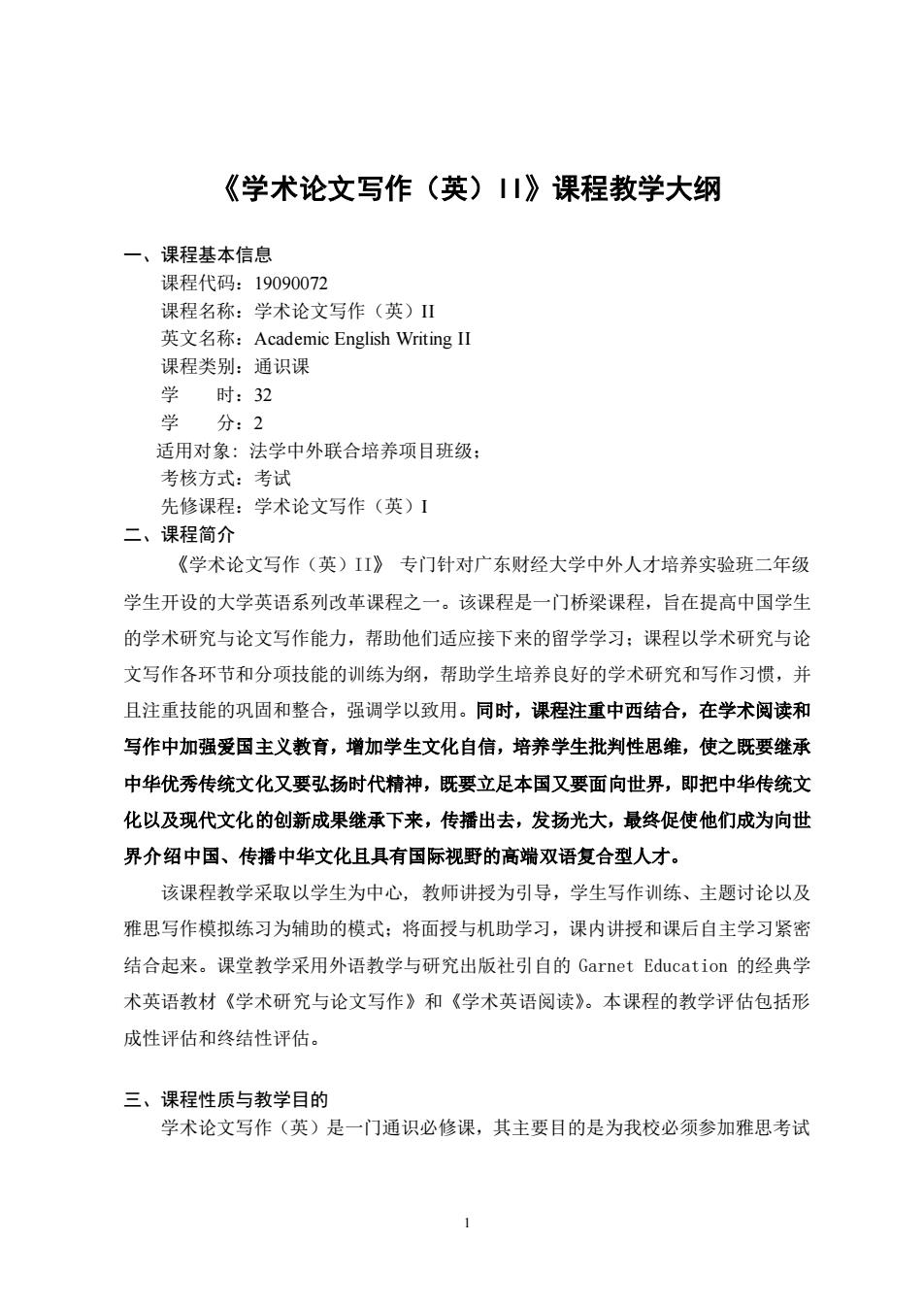
《学术论文写作(英)II》课程教学大纲 一、课程基本信息 课程代码:19090072 课程名称:学术论文写作(英)Ⅱ 英文名称:Academic English WritingⅡ 课程类别:通识课 学 时:32 学 分:2 适用对象:法学中外联合培养项目班级: 考核方式:考试 先修课程:学术论文写作(英)】 二、课程简介 《学术论文写作(英)IⅡ》专门针对广东财经大学中外人才培养实验班二年级 学生开设的大学英语系列改革课程之一。该课程是一门桥梁课程,旨在提高中国学生 的学术研究与论文写作能力,帮助他们适应接下来的留学学习:课程以学术研究与论 文写作各环节和分项技能的训练为纲,帮助学生培养良好的学术研究和写作习惯,并 且注重技能的巩固和整合,强调学以致用。同时,课程注重中西结合,在学术阅读和 写作中加强爱国主义教育,增加学生文化自信,培养学生批判性思维,使之既要继承 中华优秀传统文化又要弘扬时代精神,既要立足本国又要面向世界,即把中华传统文 化以及现代文化的创新成果继承下来,传播出去,发扬光大,最终促使他们成为向世 界介绍中国、传播中华文化且具有国际视野的高端双语复合型人才。 该课程教学采取以学生为中心,教师讲授为引导,学生写作训练、主题讨论以及 雅思写作模拟练习为辅助的模式;将面授与机助学习,课内讲授和课后自主学习紧密 结合起来。课堂教学采用外语教学与研究出版社引自的Garnet Education的经典学 术英语教材《学术研究与论文写作》和《学术英语阅读》。本课程的教学评估包括形 成性评估和终结性评估 三、课程性质与教学目的 学术论文写作(英)是一门通识必修课,其主要目的是为我校必须参加雅思考试 1
1 《学术论文写作(英)II》课程教学大纲 一、课程基本信息 课程代码:19090072 课程名称:学术论文写作(英)II 英文名称:Academic English Writing II 课程类别:通识课 学 时:32 学 分:2 适用对象: 法学中外联合培养项目班级; 考核方式:考试 先修课程:学术论文写作(英)I 二、课程简介 《学术论文写作(英)II》 专门针对广东财经大学中外人才培养实验班二年级 学生开设的大学英语系列改革课程之一。该课程是一门桥梁课程,旨在提高中国学生 的学术研究与论文写作能力,帮助他们适应接下来的留学学习;课程以学术研究与论 文写作各环节和分项技能的训练为纲,帮助学生培养良好的学术研究和写作习惯,并 且注重技能的巩固和整合,强调学以致用。同时,课程注重中西结合,在学术阅读和 写作中加强爱国主义教育,增加学生文化自信,培养学生批判性思维,使之既要继承 中华优秀传统文化又要弘扬时代精神,既要立足本国又要面向世界,即把中华传统文 化以及现代文化的创新成果继承下来,传播出去,发扬光大,最终促使他们成为向世 界介绍中国、传播中华文化且具有国际视野的高端双语复合型人才。 该课程教学采取以学生为中心, 教师讲授为引导,学生写作训练、主题讨论以及 雅思写作模拟练习为辅助的模式;将面授与机助学习,课内讲授和课后自主学习紧密 结合起来。课堂教学采用外语教学与研究出版社引自的 Garnet Education 的经典学 术英语教材《学术研究与论文写作》和《学术英语阅读》。本课程的教学评估包括形 成性评估和终结性评估。 三、课程性质与教学目的 学术论文写作(英)是一门通识必修课,其主要目的是为我校必须参加雅思考试

的中外人才培养实验班同学提供系统学习学术英语语言、培养学术论文写作能力和增 强雅思写作考试技巧,同时通过大量阅读输入提高学生的学术英语素养、学术英语交 流和跨文化交际能力,提升他们的批判性思维能力和跨文化交际意识。 学生学完该门课程后,应能达到以下要求: l)掌握基本学术论文写作技能,包括撰写abstract,introduction,,definition, conclusion的方法和paraphrasing和referencing的技巧、规范: 2)掌握学术研究的基本方法,包括选题、收集和分类资料、运用论据论证观点、 对论据的分析和解释等: 3)学生的语篇分析和概括能力,特别是改述(paraphrase)和综述(summarise))的 能力显著提升,语言表达丰富多样化: 4)学生的批判性思维、西方逻辑思维和东西方文化差异意识通过写作、教师引 导、和讨论得以相当的提升:提升学生在学术交流中的辩证性思考能力,能够坚定文 化自信,向世界“讲好中国故事,传播好中国声音,阐释好中国特色”,进一步帮助 学生树立正确价值观和加强爱国主义教育 5)学生基本了解和掌握学术论文语言特色,为学术英语写作和跨文化交际等语 言输出活动提供基础输入。 四、教学内容及要求 第一章Developing a focus (一)目的与要求 In this unit students will: learn how to choose a topic practise narrowing down the topic to establish a focus come up with a working title (二)教学内容 1,主要内容 1)Choosing a topic for your extended essay 2)Developing a topic 3)Establishing a focus 4)Establishing a working title 2.基本概念和知识点 1)How to choose a topic? The process of choosing a topic: A.Find something in your subject area you are interested in. 2
2 的中外人才培养实验班同学提供系统学习学术英语语言、培养学术论文写作能力和增 强雅思写作考试技巧,同时通过大量阅读输入提高学生的学术英语素养、学术英语交 流和跨文化交际能力,提升他们的批判性思维能力和跨文化交际意识。 学生学完该门课程后,应能达到以下要求: 1)掌握基本学术论文写作技能,包括撰写 abstract, introduction, definition, conclusion 的方法和 paraphrasing 和 referencing 的技巧、规范; 2)掌握学术研究的基本方法,包括选题、收集和分类资料、运用论据论证观点、 对论据的分析和解释等; 3)学生的语篇分析和概括能力,特别是改述(paraphrase)和综述(summarise)的 能力显著提升,语言表达丰富多样化; 4)学生的批判性思维、西方逻辑思维和东西方文化差异意识通过写作、教师引 导、和讨论得以相当的提升;提升学生在学术交流中的辩证性思考能力,能够坚定文 化自信,向世界“讲好中国故事,传播好中国声音,阐释好中国特色”,进一步帮助 学生树立正确价值观和加强爱国主义教育。 5)学生基本了解和掌握学术论文语言特色,为学术英语写作和跨文化交际等语 言输出活动提供基础输入。 四、教学内容及要求 第一章 Developing a focus (一)目的与要求 In this unit students will: • learn how to choose a topic • practise narrowing down the topic to establish a focus • come up with a working title (二)教学内容 1.主要内容 1) Choosing a topic for your extended essay 2) Developing a topic 3) Establishing a focus 4) Establishing a working title 2. 基本概念和知识点 1) How to choose a topic? The process of choosing a topic: A. Find something in your subject area you are interested in
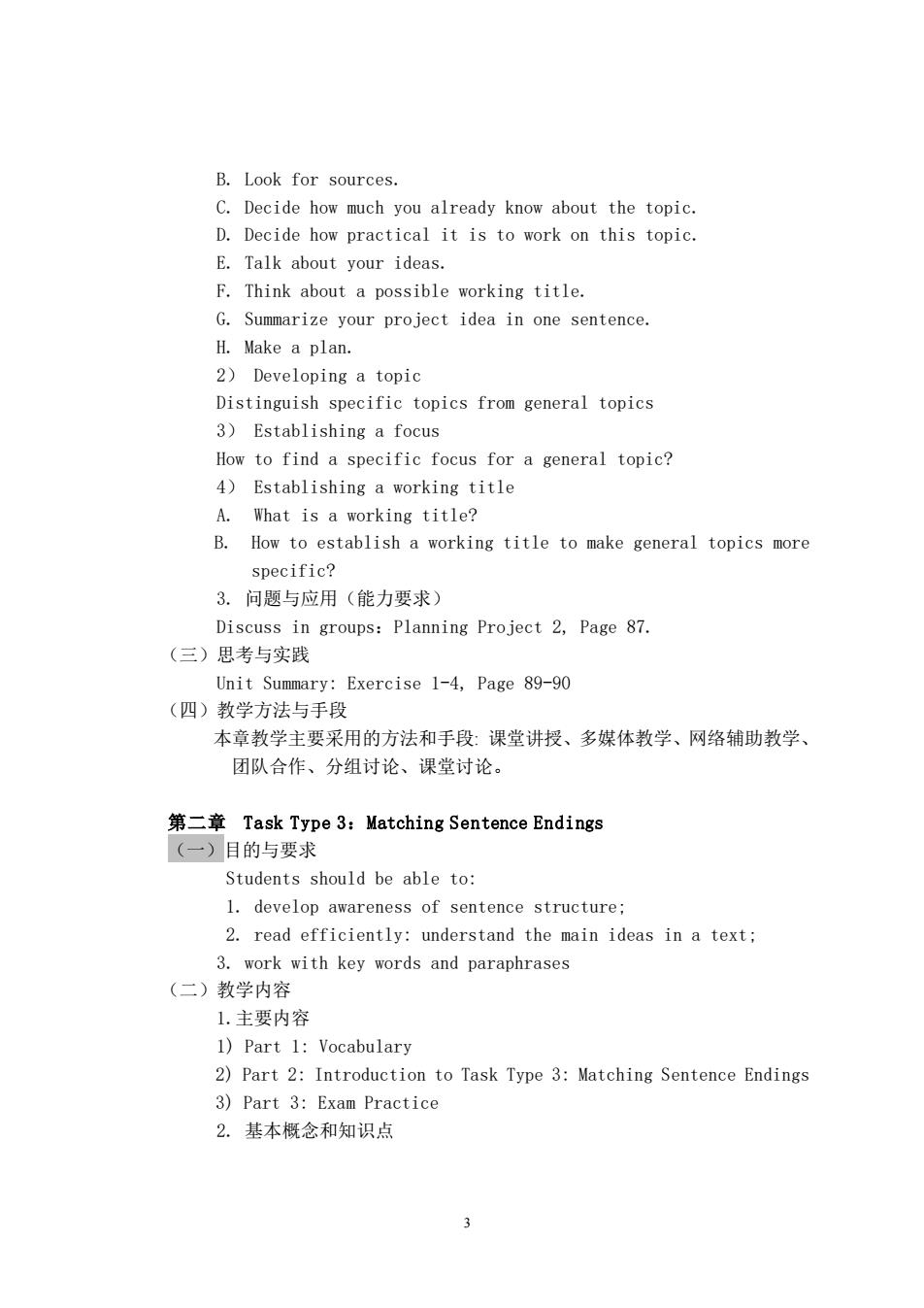
B.Look for sources. C.Decide how much you already know about the topic D.Decide how practical it is to work on this topic. E.Talk about your ideas. F.Think about a possible working title. G.Summarize your project idea in one sentence. H.Make a plan. 2)Developing a topic Distinguish specific topics from general topics 3)Establishing a focus How to find a specific focus for a general topic? 4)Establishing a working title A.What is a working title? B.How to establish a working title to make general topics more specific? 3.问题与应用(能力要求) Discuss in groups:Planning Project 2,Page 87 (三)思考与实践 Unit Summary:Exercise 1-4,Page 89-90 (四)教学方法与手段 本章教学主要采用的方法和手段:课堂讲授、多媒体教学、网络辅助教学 团队合作、分组讨论、课堂讨论。 第二章Task Type3:Matching Sentence Endings (一)目的与要求 Students should be able to: 1.develop awareness of sentence structure 2.read efficiently:understand the main ideas in a text: 3.work with key words and paraphrases (二)教学内容 1.主要内容 1)Part 1:Vocabulary 2)Part 2:Introduction to Task Type 3:Matching Sentence Endings 3)Part 3:Exam Practice 2.基本概念和知识点 3
3 B. Look for sources. C. Decide how much you already know about the topic. D. Decide how practical it is to work on this topic. E. Talk about your ideas. F. Think about a possible working title. G. Summarize your project idea in one sentence. H. Make a plan. 2) Developing a topic Distinguish specific topics from general topics 3) Establishing a focus How to find a specific focus for a general topic? 4) Establishing a working title A. What is a working title? B. How to establish a working title to make general topics more specific? 3. 问题与应用(能力要求) Discuss in groups:Planning Project 2, Page 87. (三)思考与实践 Unit Summary: Exercise 1-4, Page 89-90 (四)教学方法与手段 本章教学主要采用的方法和手段: 课堂讲授、多媒体教学、网络辅助教学、 团队合作、分组讨论、课堂讨论。 第二章 Task Type 3:Matching Sentence Endings (一)目的与要求 Students should be able to: 1. develop awareness of sentence structure; 2. read efficiently: understand the main ideas in a text; 3. work with key words and paraphrases (二)教学内容 1.主要内容 1) Part 1: Vocabulary 2) Part 2: Introduction to Task Type 3: Matching Sentence Endings 3) Part 3: Exam Practice 2. 基本概念和知识点
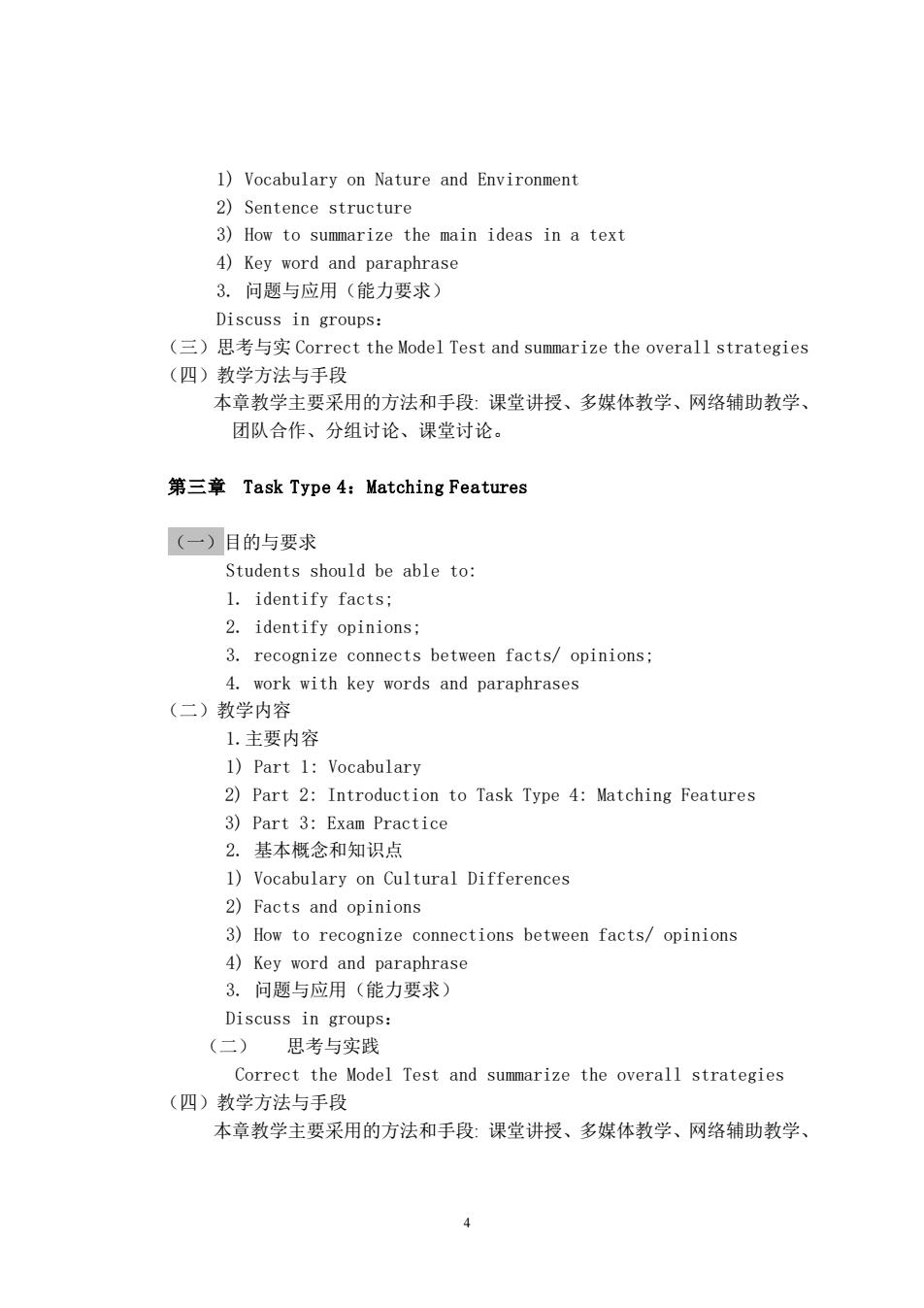
1)Vocabulary on Nature and Environment 2)Sentence structure 3)How to summarize the main ideas in a text 4)Key word and paraphrase 3.问题与应用(能力要求】 Discuss in groups: (三)思考与实Correct the Model Test and summarize the overall strategies (四)教学方法与手段 本章教学主要采用的方法和手段:课堂讲授、多媒体教学、网络辅助教学、 团队合作、分组讨论、课堂讨论。 第三章Task Type4:Matching Features (一)目的与要求 Students should be able to 1.identify facts; 2.identify opinions: 3.recognize connects between facts/opinions 4.work with key words and paraphrases (二)教学内容 1.主要内容 1)Part 1:Vocabulary 2)Part 2:Introduction to Task Type 4:Matching Features 3)Part 3:Exam Practice 2.基本概念和知识点 1)Vocabulary on Cultural Differences 2)Facts and opinions 3)How to recognize connections between facts/opinions 4)Key word and paraphrase 3.问题与应用(能力要求) Discuss in groups: (一)用老考与实践 Correct the Model Test and summarize the overall strategies (四)教学方法与手段 本章教学主要采用的方法和手段:课堂讲授、多媒体教学、网络辅助教学、 4
4 1) Vocabulary on Nature and Environment 2) Sentence structure 3) How to summarize the main ideas in a text 4) Key word and paraphrase 3. 问题与应用(能力要求) Discuss in groups: (三)思考与实 Correct the Model Test and summarize the overall strategies (四)教学方法与手段 本章教学主要采用的方法和手段: 课堂讲授、多媒体教学、网络辅助教学、 团队合作、分组讨论、课堂讨论。 第三章 Task Type 4:Matching Features (一)目的与要求 Students should be able to: 1. identify facts; 2. identify opinions; 3. recognize connects between facts/ opinions; 4. work with key words and paraphrases (二)教学内容 1.主要内容 1) Part 1: Vocabulary 2) Part 2: Introduction to Task Type 4: Matching Features 3) Part 3: Exam Practice 2. 基本概念和知识点 1) Vocabulary on Cultural Differences 2) Facts and opinions 3) How to recognize connections between facts/ opinions 4) Key word and paraphrase 3. 问题与应用(能力要求) Discuss in groups: (二) 思考与实践 Correct the Model Test and summarize the overall strategies (四)教学方法与手段 本章教学主要采用的方法和手段: 课堂讲授、多媒体教学、网络辅助教学
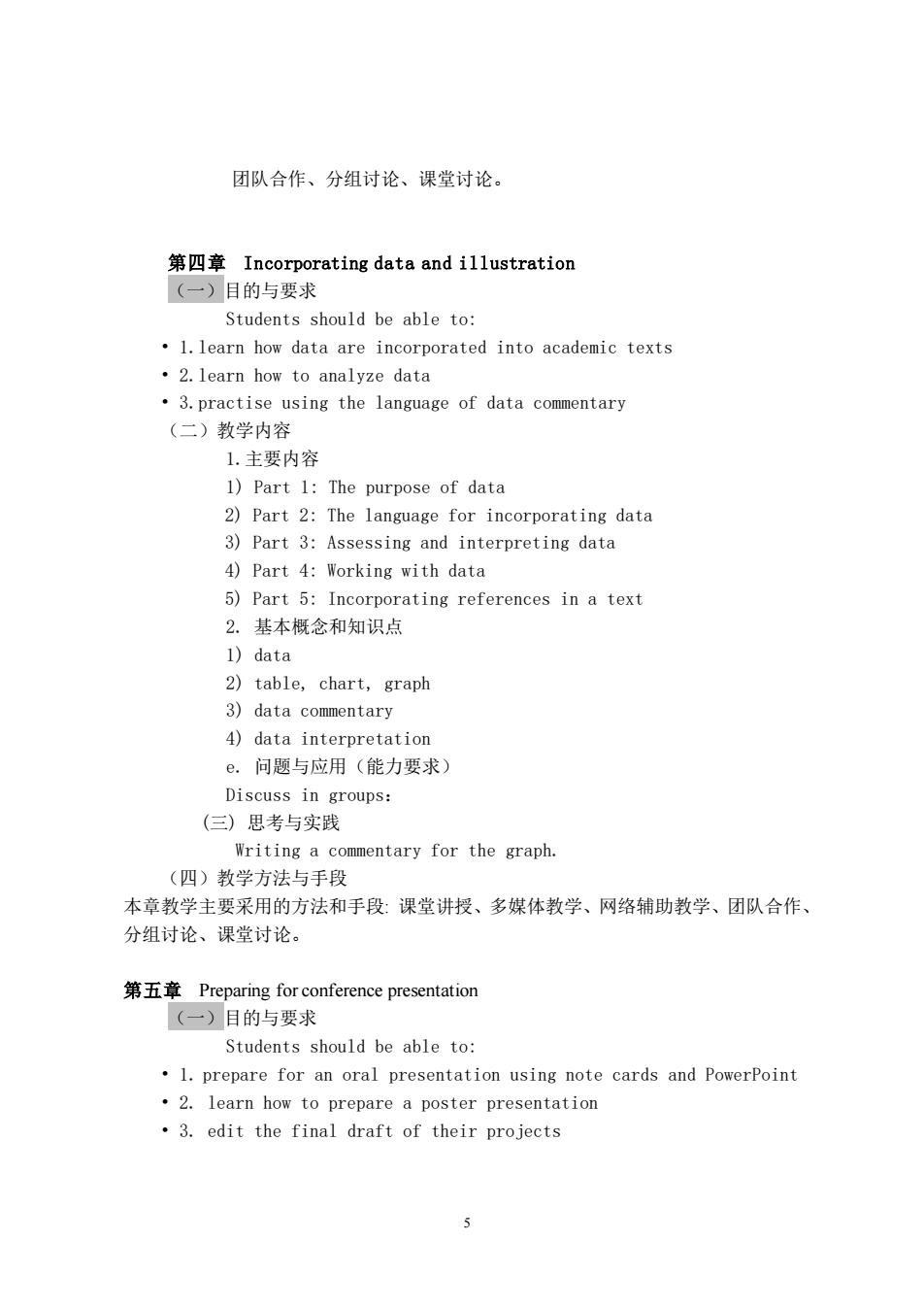
团队合作、分组讨论、课堂讨论。 第四章Incorporating data and illustration (一)目的与要求 Students should be able to: 1.learn how data are incorporated into academic texts 2.learn how to analyze data 3.practise using the language of data commentary (二)教学内容 1.主要内容 1)Part 1:The purpose of data 2)Part 2:The language for incorporating data 3)Part 3:Assessing and interpreting data 4)Part 4:Working with data 5)Part 5:Incorporating references in a text 2.基本概念和知识点 1)data 2)table,chart,graph 3)data commentary 4)data interpretation e.问题与应用(能力要求) Discuss in groups (三)思考与实践 Writing a commentary for the graph. (四)教学方法与手段 本章教学主要采用的方法和手段:课堂讲授、多媒体教学、网络辅助教学、团队合作、 分组讨论、课觉讨论。 第五章Preparing for conference presentation (一)目的与要求 students should be able toa 1.prepare for an oral presentation using note cards and PowerPoint .2.learn how to prepare a poster presentation 3.edit the final draft of their projects 5
5 团队合作、分组讨论、课堂讨论。 第四章 Incorporating data and illustration (一)目的与要求 Students should be able to: • 1.learn how data are incorporated into academic texts • 2.learn how to analyze data • 3.practise using the language of data commentary (二)教学内容 1.主要内容 1) Part 1: The purpose of data 2) Part 2: The language for incorporating data 3) Part 3: Assessing and interpreting data 4) Part 4: Working with data 5) Part 5: Incorporating references in a text 2. 基本概念和知识点 1) data 2) table, chart, graph 3) data commentary 4) data interpretation e. 问题与应用(能力要求) Discuss in groups: (三) 思考与实践 Writing a commentary for the graph. (四)教学方法与手段 本章教学主要采用的方法和手段: 课堂讲授、多媒体教学、网络辅助教学、团队合作、 分组讨论、课堂讨论。 第五章 Preparing for conference presentation (一)目的与要求 Students should be able to: • 1. prepare for an oral presentation using note cards and PowerPoint • 2. learn how to prepare a poster presentation • 3. edit the final draft of their projects
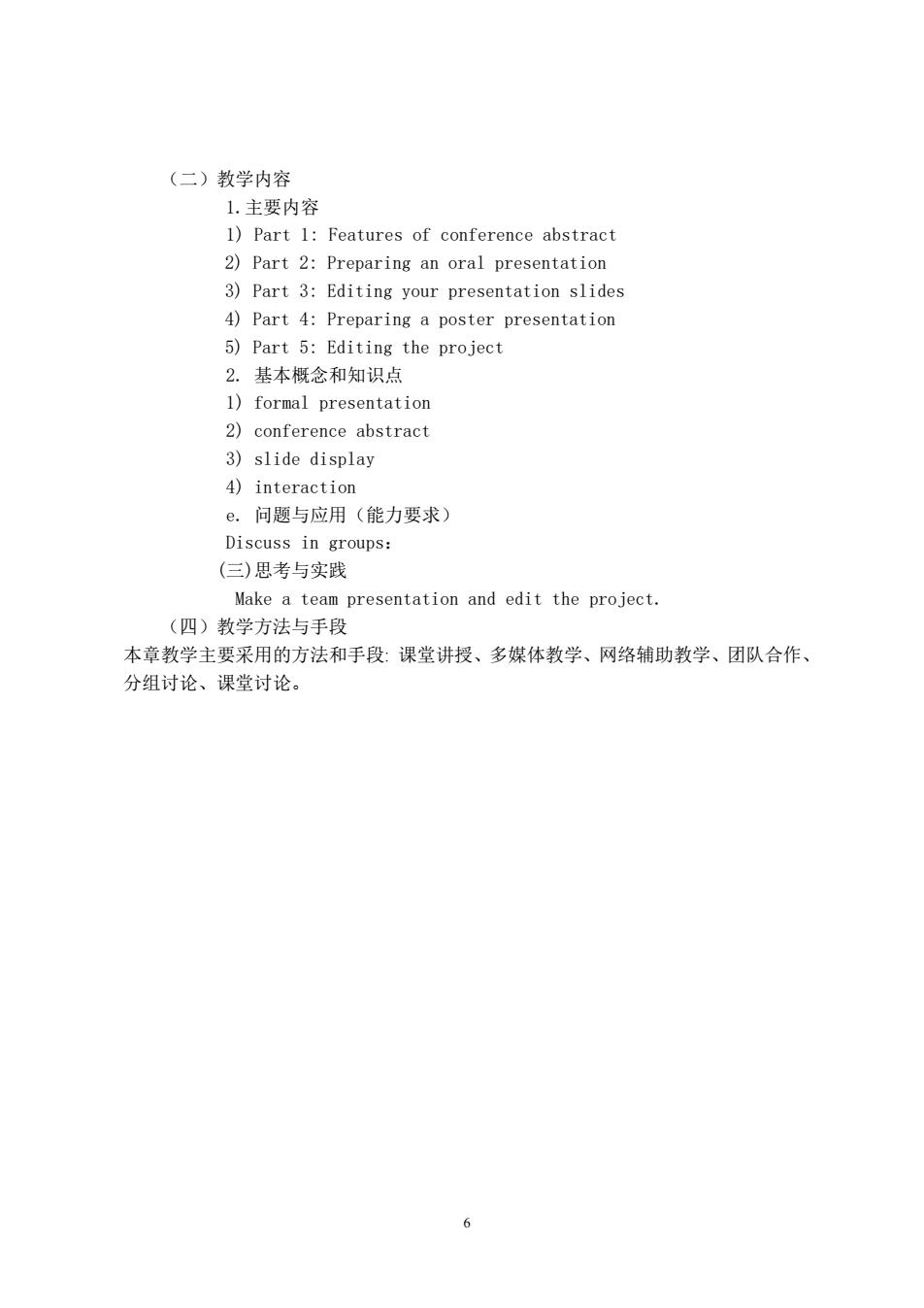
(二)教学内容 1.主要内容 1)Part 1:Features of conference abstract 2)Part 2:Preparing an oral presentation 3)Part 3:Editing your presentation slides 4)Part 4:Preparing a poster presentation 5)Part 5:Editing the project 2.基本概念和知识点 1)formal presentation 2)conference abstract 3)slide display 4)interaction e.问题与应用(能力要求) Discuss in groups: (三)思考与实践 Make a team presentation and edit the project. (四)教学方法与手段 本章教学主要采用的方法和手段:课堂讲授、多媒体教学、网络辅助教学、团队合作、 分组讨论、课堂讨论。 6
6 (二)教学内容 1.主要内容 1) Part 1: Features of conference abstract 2) Part 2: Preparing an oral presentation 3) Part 3: Editing your presentation slides 4) Part 4: Preparing a poster presentation 5) Part 5: Editing the project 2. 基本概念和知识点 1) formal presentation 2) conference abstract 3) slide display 4) interaction e. 问题与应用(能力要求) Discuss in groups: (三)思考与实践 Make a team presentation and edit the project. (四)教学方法与手段 本章教学主要采用的方法和手段: 课堂讲授、多媒体教学、网络辅助教学、团队合作、 分组讨论、课堂讨论
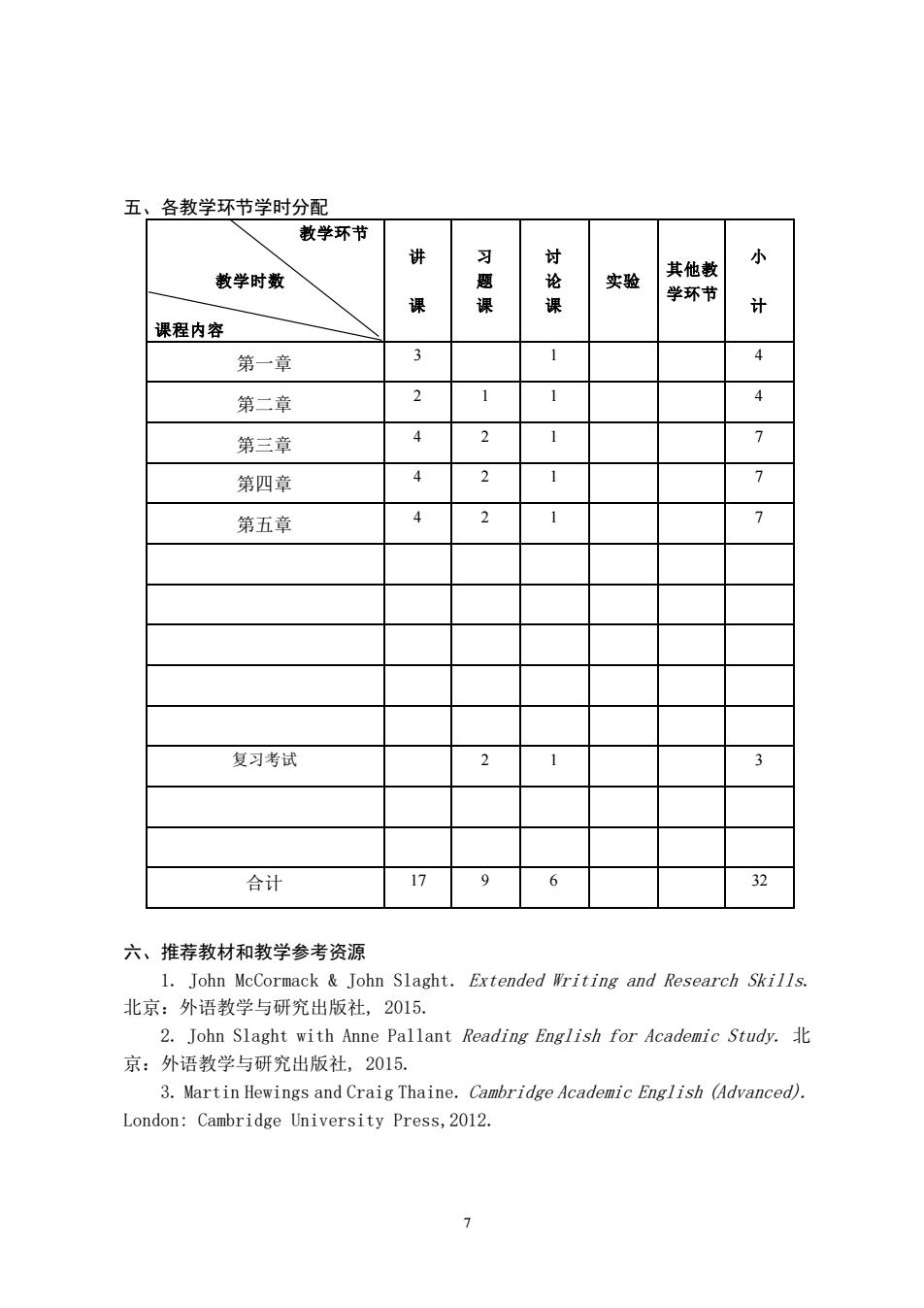
五、各教学环节学时分配 教学环节 少 讨 教学时数 实验 其他教 小 课 学环节 课程内容 第一章 4 第二章 第三章 第四章 4 第五章 4 2 1 复习考试 21 3 合计 9 6 32 六、推荐教材和教学参考资源 1 Iohn McCormack&Iohn slaght.Ertended writing and Research skills. 北京:外语教学与研究出版社,2015. 2.John Slaght with Anne Pallant Reading English for Academic Study. 京:外语教学与研究出版社,2015. 3.Martin Hewings and Craig Thaine.Cambridge Academic English (Advanced). London:Cambridge University Press,2012. 7
7 五、各教学环节学时分配 教学环节 教学时数 课程内容 讲 课 习 题 课 讨 论 课 实验 其他教 学环节 小 计 第一章 3 1 4 第二章 2 1 1 4 第三章 4 2 1 7 第四章 4 2 1 7 第五章 4 2 1 7 复习考试 2 1 3 合计 17 9 6 32 六、推荐教材和教学参考资源 1. John McCormack & John Slaght. Extended Writing and Research Skills. 北京:外语教学与研究出版社, 2015. 2. John Slaght with Anne Pallant Reading English for Academic Study. 北 京:外语教学与研究出版社, 2015. 3. Martin Hewings and Craig Thaine. Cambridge Academic English (Advanced). London: Cambridge University Press,2012
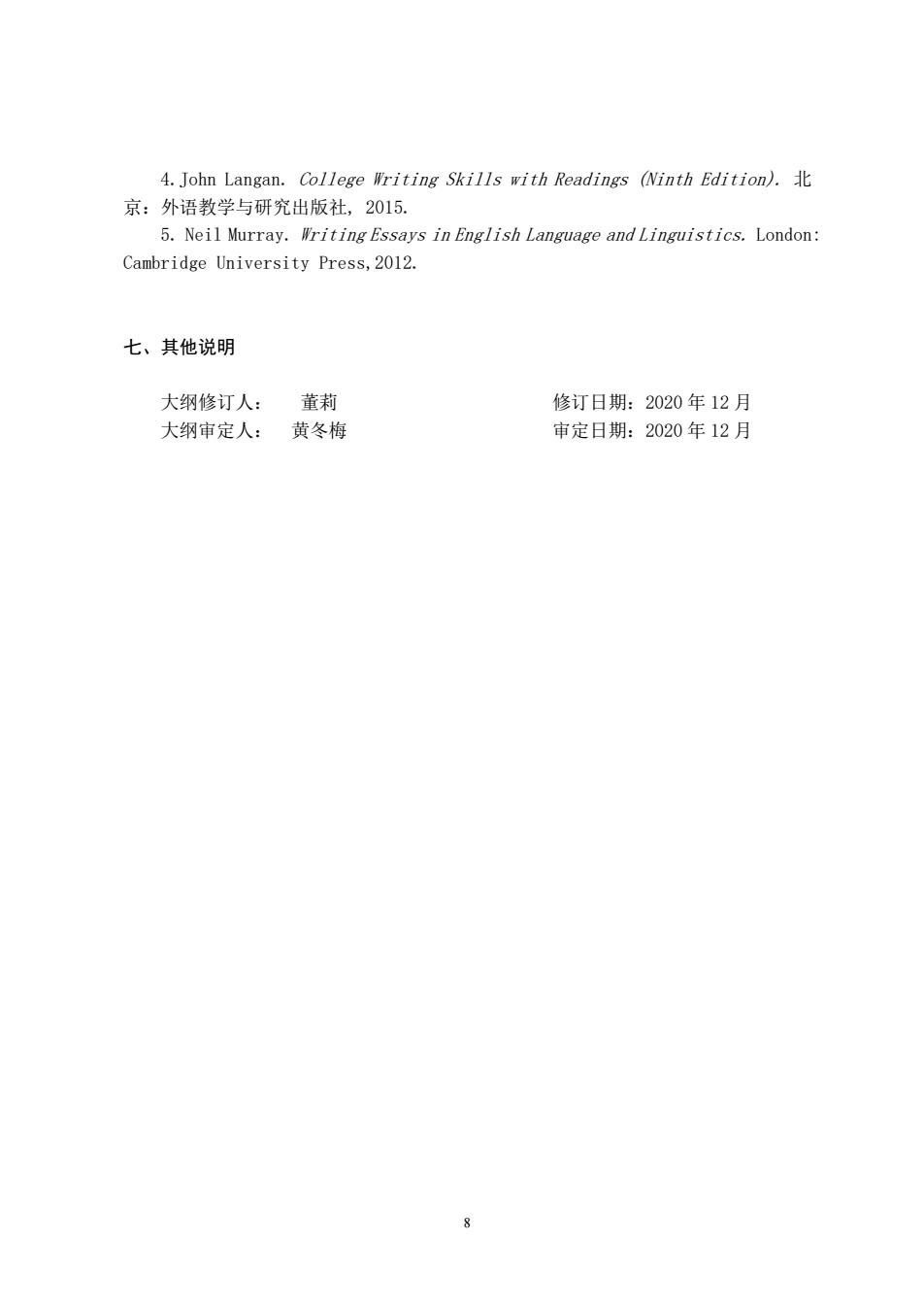
4.John Langan.College Writing Skills with Readings (Ninth Edition). 京:外语教学与研究出版社,2015. 5.Neil Murray.Writing Essays in English Language and Linguistics.London: Cambridge University Press,2012 七、其他说明 大纲修订人: 董莉 修订日期:2020年12月 大纲审定人:黄冬梅 审定日期:2020年12月
8 4.John Langan. College Writing Skills with Readings (Ninth Edition). 北 京:外语教学与研究出版社, 2015. 5. Neil Murray. Writing Essays in English Language and Linguistics. London: Cambridge University Press,2012. 七、其他说明 大纲修订人: 董莉 修订日期:2020 年 12 月 大纲审定人: 黄冬梅 审定日期:2020 年 12 月